Related Research Articles

Chiang Kai-shek, also known as Chiang Chung-cheng and Jiang Jieshi, was a Chinese Nationalist politician, revolutionary and military leader, who served as the leader of the Republic of China (ROC) from 1928 to his death in 1975 – until 1949 in mainland China and from then on in Taiwan. After his rule was confined to Taiwan following his defeat by Mao Zedong in the Chinese Civil War, he continued claiming to head the legitimate Chinese government in exile.
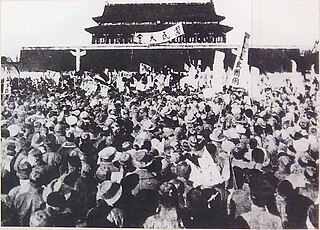
The May Fourth Movement was a Chinese anti-imperialist, cultural, and political movement which grew out of student protests in Beijing on May 4, 1919. Students gathered in front of Tiananmen to protest the Chinese government's weak response to the Treaty of Versailles decision to allow Japan to retain territories in Shandong that had been surrendered to Germany after the Siege of Tsingtao in 1914. The demonstrations sparked nation-wide protests and spurred an upsurge in Chinese nationalism, a shift towards political mobilization away from cultural activities, a move towards a populist base and away from traditional intellectual and political elites.
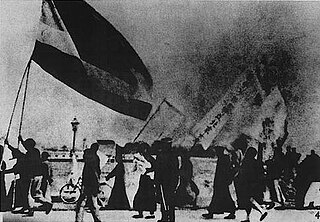
Chinese nationalism is a form of nationalism in the People's Republic of China and the Republic of China (Taiwan) which asserts that the Chinese people are a nation and promotes the cultural and national unity of all Chinese people, technically it is slightly distinct from Han Chinese nationalism i.e. nationalism of main ethnicity of China, a form of Chinese nationalism applied exclusively to the Han Chinese. In extreme cases of Han Chinese nationalism a sense of jingoism that is felt by purely Han Chinese people who deem themselves superior to ethnic minorities in China and other peoples in the world. According to Sun Yat-sen's philosophy in the Three Principles of the People, Chinese nationalism should be a form of civic nationalism constructed on top of a united value, however this has not been fully recognised or applied in practice by successors.
The New Culture Movement was a movement in China in the 1910s and 1920s that criticized classical Chinese ideas and promoted a new Chinese culture based upon progressive, modern and western ideals like democracy and science. Arising out of disillusionment with traditional Chinese culture following the failure of the Republic of China to address China's problems, it featured scholars such as Chen Duxiu, Cai Yuanpei, Chen Hengzhe, Li Dazhao, Lu Xun, Zhou Zuoren, He Dong, Qian Xuantong, Liu Bannong, Bing Xin, and Hu Shih, many classically educated, who led a revolt against Confucianism. The movement was launched by the writers of New Youth magazine, where these intellectuals promoted a new society based on unconstrained individuals rather than the traditional Confucian system. The movement promoted:

Trường Chinh was a Vietnamese communist political leader and theoretician. He was one of the key figures of Vietnamese politics. He played a major role in the anti-French colonialism movement and finally after decades of protracted war in Vietnam, the Vietnamese defeated the colonial power. He was the think-tank of the Communist Party who determined the direction of the communist movement, particularly in the anti-French colonialism movement. After the declaration of independence in September 1945, Trường Chinh played an important role in shaping the politics of the Democratic Republic of Vietnam (DRV) and creating the socialist structure of the new Vietnam.
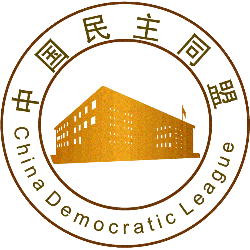
The China Democratic League (CDL) is one of the eight legally recognised minor political parties in the People's Republic of China under the Chinese Communist Party's United Front. The CDL was originally founded in 1941 as an umbrella coalition group of the Chinese National Socialist Party, the Chinese Youth Party and the Chinese Peasants' and Workers' Democratic Party to fight the Imperial Japanese Army while providing for a "Third Way".

The Nationalist government, officially the National Government of the Republic of China, also known as the Second Republic of China or simply as the Republic of China, refers to the government of the Republic of China from 1 July 1925 to 20 May 1948, led by the Kuomintang.

The Nanjing decade is an informal name for the decade from 1927 to 1937 in the Republic of China. It began when Nationalist Generalissimo Chiang Kai-shek took Nanjing from Zhili clique warlord Sun Chuanfang halfway through the Northern Expedition in 1927. Chiang declared it to be the national capital despite the existence of a left-wing Nationalist government in Wuhan. The Wuhan faction gave in and the Northern Expedition continued until the Beiyang government in Beijing was overthrown in 1928. The decade ended with the outbreak of the Second Sino-Japanese War in 1937 and the retreat of the Nationalist government to Wuhan. GDP growth averaged 3.9 per cent a year from 1929 to 1941 and per capita GDP about 1.8 per cent.
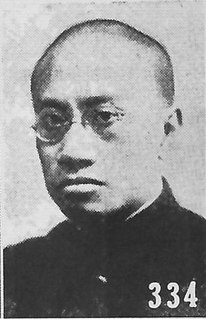
Liang Shuming, born Liang Huanding (梁焕鼎), courtesy name Shouming (壽銘), was a Chinese philosopher, politician, and writer in the Rural Reconstruction Movement during the late Qing dynasty and early Republican eras of Chinese history.
Y. C. James Yen, known to his many English speaking friends as "Jimmy," was a Chinese educator and organizer known for his work in mass literacy and rural reconstruction, first in China, then in many countries.
Sino-American Joint Commission on Rural Reconstruction is a commission established in 1948 in mainland China. After the Chinese Civil War, the JCRR then moved to Taiwan, where its work has been widely credited with laying the agricultural basis in the 1950s and 1960s for Taiwan's outstanding economic growth in the following decades by a coordinated program of economic, social, and technical development.
Sidney D. Gamble was born in Cincinnati, Ohio, to David Berry and Mary Huggins Gamble; grandson of James Gamble, who, with William Procter, founded Procter & Gamble in 1837. in 1912 he graduated magna cum laude from Princeton University with a Bachelor of Literature degree and was elected to Phi Beta Kappa. He visited China for four extended periods, 1908, 1917–1919, 1924–27, and 1931–1932, doing Christian social work for YMCA and conducting social surveys. He is now best known for his remarkable and extensive photographs of Peking and North China.
New Rural Reconstruction is an intellectual current and social movement initiated by Wen Tiejun and other activists to address the crisis they saw in the Chinese countryside at the start of the 21st century. As of 2009, at its core there are several NGOs and academic institutions, dozens of rural cooperatives and associations, and hundreds of self-conscious participants. More broadly, the ideas and spirit of NRR have influenced a growing movement of rural experimentation, including many activists who do not use the term "NRR".

The Ding Xian Experiment during the Republican period of Chinese history was a project in Rural Reconstruction sponsored by James Yen's Mass Education Movement (MEM) 中华平民教育促进会 in Ding Xian, Hebei, some 200 miles south of Beijing.
International Institute of Rural Reconstruction, also known as IIRR is a non-profit organization that helps empower rural communities by making them self-sufficient. By offering programs across health, education, environment and livelihood, its goal is to have rural communities take charge of their own success. The organization has delivered programs to more than 40 countries in Asia, Africa and Latin America and directly impacted the lives of over 5 million people as of 2019.
Ch'ing-k'un Yang, better known as C. K. Yang, was an American sociologist who pioneered the application of sociological theory to the study of China. He was known for his contributions to the study of Chinese religion and his argument that religion in China was "diffuse" and present in many aspects rather than being institutionalized in churches.

The Land Reform Movement, also known by the Chinese abbreviation Tǔgǎi (土改), was a campaign by the Chinese Communist Party (CCP) leader Mao Zedong during the late phase of the Chinese Civil War and the early People's Republic of China. The campaign involved the mass killing of landlords by tenants and land redistribution to the peasantry. The estimated number of casualties of the movement ranges from hundreds of thousands to millions. In terms of the CCP's evaluation, Zhou Enlai estimated 830,000 had been killed and Mao Zedong estimated as many as 2 to 3 million were killed.
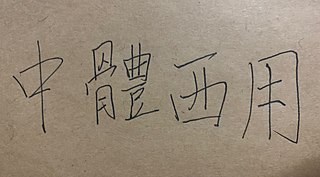
The idea of "Chinese Learning as Substance, Western Learning for Application" was initially proposed by Feng Guifen in his Xiaopinlu kangyi, written in 1861 after the Second Opium War. At the time, leading Chinese thinkers were interrogating how to approach the threat posed by encroaching Western states. Feng argued for China's self-strengthening and industrialization by borrowing Western technology and military systems, while retaining core Neo-Confucian principles. These ideas were further elaborated on by Zhang Zhidong in 1898 in his book Quanxue pian as "Traditional (Chinese) learning as substance, New (Western) learning as application" (“舊學為體,新學為用”). “Zhongti xiyong” became a popular slogan used in the late Qing Reforms, including the Self-Strengthening Movement and Hundred Days' Reform. The concept was widespread among intellectuals in the late 19th and early 20th century, and it remains relevant in the modern studies of China-West cultural relationship.
Andrew G. Walder is an American political sociologist specializing in the study of Chinese society. He has taught at Harvard University and Stanford University, where he joined the faculty in 1997 and is the Denise O'Leary & Kent Thiry Professor of the School of Humanities and Sciences, and a Senior Fellow of the Freeman-Spogli Institute for International Studies at Stanford University.
Guy Salvatore Alitto is an American academic in the History and East Asian Languages and Civilization Departments at the University of Chicago. He is known in China for revitalizing the scholarship on Chinese Confucian scholar Liang Shuming. He is also often quoted in popular Chinese media sources. He is best known in America for his scholarship and for his role as translator for the first official Chinese delegations to the United States after Richard Nixon's first visits to China.
References
- Guy Alitto, The Last Confucian: Liang Shu-Ming and the Chinese Dilemma of Modernity (Berkeley: University of California Press, 1979).
- Buck, Pearl S. (1945), Tell the People - Talks with James Yen About the Mass Education Movement, New York: John Day – via Internet Archive
- Charles Hayford, To the People: James Yen and Village China (New York: Columbia University Press, 1990).
- Martha McKee Keehn, ed., Y.C. James Yen's Thought on Mass Education and Rural Reconstruction : China and Beyond: Selected Papers from an International Conference Held in Shijiazhuang, China, May 27-June 1, 1990 (New York: International Institute of Rural Reconstruction, 1993).
- Merkel-Hess, Kate (2016). The Rural Modern: Reconstructing the Self and State in Republican China. Chicago; London: The University of Chicago Press. ISBN 9780226383279.